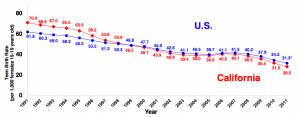Amidst the muddled sea of stories talking about teenagers and sex, one point stands clear. Teenagers now are getting pregnant less than ever before.
Teen birth rates in California have declined annually among all ages and ethnicities since 1991.
According to the California Department of Public Health, California’s average teen birth rate in 1991 was far higher than that of the U.S. average for that year, however California’s rate as of 2011 was slightly smaller than that of the U.S. average. This change coincides with a 23% increase in the number of state abortion clinics as reported by the Guttmacher Institute, and an increase in contraceptive use being taught in sex education classes.

The steepest statewide decline in teen birth rate occurred between 2007-2011. California’s sexual education was reformed in 2008 by the inclusion of a new education code.
EC Section 51933 served to reform California’s sexual education programs, as it, “prohibits ‘abstinence-only’ education, in which information about preventing pregnancy and STDs is limited to instruction on abstinence from sexual activity.”
In 2003, the California Department of Education reported that 96% of California school districts provided comprehensive sexual health education. The course, which teaches “education regarding human development and sexuality, including education on pregnancy, family planning, and STDs,” is not required by the state.
Today, the only sexual education California public schools are required to teach is HIV/AIDS prevention.
The primary method for teaching prevention in 2003 was abstinence, which 99% of California high school students reported being taught about. In the same year, 80% of California high school students reported being taught condom effectiveness.
Unfortunately, a report on the content of California’s sexual education classes has not been released since 2003 to allow for more present data.
During the years in which teen birth rate dropped, there was a slight increase in the number of California abortion clinics.
In 2008, there were 522 abortion clinics in California, a 23% increase from the 424 clinics present in 2005.
However, according to the Guttmacher Institute, as the number of abortion clinics in California have increased, abortion rates have decreased.
From 1991 to 2008, the rate of abortion for women between the ages of 15 and 44 nearly halved, and the rate continues on a downward trend.
As of January 1, 2014, there are absolutely no major restrictions on abortion in California; such as waiting periods or parental involvement for those under 18.
Last year, Plan B, commonly known as “the morning after pill” became available as an over the counter drug to anyone over the age of 15. Plan B is an emergency contraceptive pill which can prevent pregnancy for up to five days after sex.
Marin County has maintained a consistently low teen birth rate relative to the rest of California. From 2009-2011, the California Department of Public Health reported that Marin County had the lowest statistically significant teen birth rate in California. This does not mean that Marin had the lowest teen birth rate in California, as some counties were excluded from this report because there were too few teen births to establish a rate.






